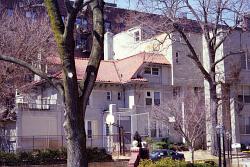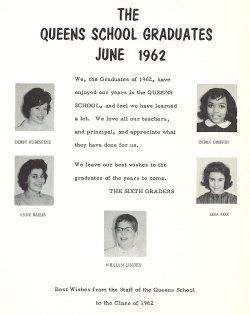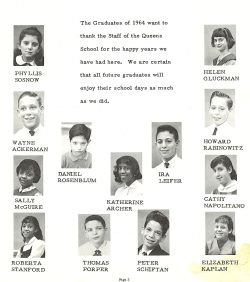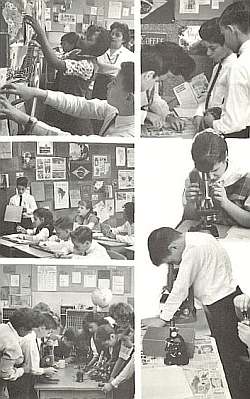 | |||||||
| Home | Email Us | Find It | What's New | Back | Next | ||
| VIEWER MESSAGES | ||
|
| MISCELLANEOUS | ||||
|
||||

These images did not appear in the original article
Click on images to enlarge    |
Parents Work With Staff at
Queens School
Queens School
Source:
- June 1962 yearbook scans courtesy of Peter Schiftan
[Reprinted from an unknown issue of the Community News]
At first glance, 83-96 117th Street, on the outside looks very much like one of the many lovely homes in Kew Gardens is noted for. As a matter of fact, it was actually a mansion, complete with tile fireplace, one of the last houses designed by noted architect, Stanford White.
But a second glance reveals children's drawings in the windows and a sign on the lawn identifies it as the Queens School.
The Queens School is a non-profit co-operative school, a community of teachers, parents and director who work together for the benefit of the children. Founded in 1946, it has been providing alternative education to that offered in the public schools for children from kindergarten through the eighth grade.
Here, in what some people call "the little yellow schoolhouse," about 200 children attend classes in a school that, as one parent of a child attending, put it, is "a school where the child is important, not only the teacher; where the children are happy, where it is no crime to laugh in the halls, and where the youngsters have fun while learning.
There is no structured program as such in Queens School. Instead, the program is individualized so that each child achieves his optimum.
Since children do not develop at the same rate, the school believes in giving each child individual attention with the emphasis on the way children learn. This means preparing flexible programs rather than expecting students to conform to one rigidly set program.
"It's a school," says Michael Barr, whose two children are students there, "where the teachers eat lunch with the kids, and where the kids call the teachers by their first names. Disrespectful? No, indeed, for in this school, the teachers get respect because they're nice people, not because they are the voice of authority."
Enrollment is limited to 15-20 children per class, which both parents and teachers agree is as large as any class should be, for the purposes of both teaching and learning.
Twelve Classrooms
The school is a modern, fireproof building with 12 classrooms, a science lab, a library and a multi-purpose room which is used for music class, assemblies and other group activities. There is also a fenced-in gym and play area on the roof.
Forest Park is also utilized as an outdoor classroom and its playing fields are used by the Physical Education classes. The neighborhood "Y" is used for swimming instruction.
Testing includes those tests required by the State of New York of all accredited schools. In determining placement, a child's social, intellectual and emotional development is considered, as well as his chronological age. This sometimes results in inter-age grouping.
And, as Muriel Turner, a teacher in the upper school points out, this means that a child in the sixth grade may be doing tenth grade math.
Open Meetings
"One of the great things about this school," adds Mr. Barr, "is that the Board of Directors' meetings are open to all of us, and they are always willing to listen."
This willingness to listen, points out Mrs. Turner, is also passed on to the teachers. If they have an idea they would like to try out, they almost always get permission to do so.
The school believes that part of its uniqueness lies in making a curriculum live. To this end, they have performed their own mock Senate in government classes and studied American folk songs as an adjunct to the study of American history.
The children do not receive grades. Instead, parents get written reports at the end of the school year. Contact between parent and teacher is maintained in periodically scheduled individual and group meetings. The teachers and director are always available to discuss any problems or questions parents may have concerning their child's progress.
Since the school is a coooperative, parents serve on the Board of Directors and, in addition to sharing in the responsibility for the fiscal management of the school, are also involved in the discussion of new policy, curriculum (though the educational policy is the final responsibility of the teachers and the director) and serve on many of the committees, along with the teaching staff.
"Because we aspire to be a 'school without walls,'" says Mrs. Turner, "we take our youngsters out into the community in a meaningful way. They have made questionaires and interviewed people in the community about public issues of improtance to us all."
Beginning in the fourth grade, overnight trips start, to such places as Sturbridge Village, Mass., Washington, D.C., and the Shakespeare Festival in Stratford, Conn.
Starting in kindergarten, all children receive instruction in a foreign language and culture. The Physical Education program emphasizes physical fitness in everyday life, and in the second grade, the children begin participation in the swimming program.
Director
Director of the Queens School is William Gumm, who taught for 12 years in the Nassau County Public School system, and for three years supervised student teachers and instructed teachers in methodology in the Queens College teacher training program. For three years Mr. Gumm directed a cooperative bi-national school in Bolivia, and upon his return to this country, he participated in an experimental education project in the New York City public school system. From this position he came to the Queens School.
The underlying philosophy behind the Queens School can best be summed up by quoting a paragraph from a brochure describing the facility - "We hope that each student who completes the Queens School programs will be an active, positive and constructive participant in life. If we can graduate that kind of person, we will feel that we have succeeded."